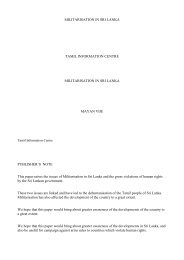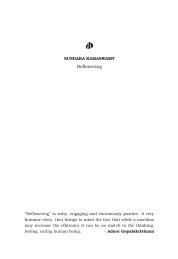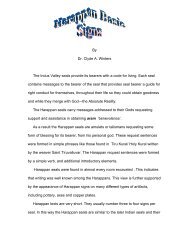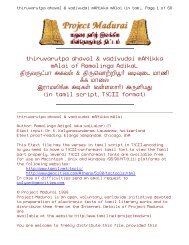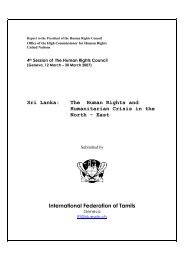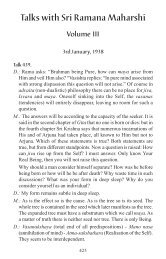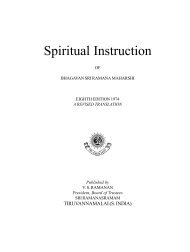Asymmetric Warfare And Low Intensity Maritime Operations
Asymmetric Warfare And Low Intensity Maritime Operations
Asymmetric Warfare And Low Intensity Maritime Operations
- No tags were found...
You also want an ePaper? Increase the reach of your titles
YUMPU automatically turns print PDFs into web optimized ePapers that Google loves.
ORF Occasional Paper<strong>Asymmetric</strong> <strong>Warfare</strong> <strong>And</strong> LIMO: Challenges For Indian NavyEelam) mercenaries landed in the Maldives. 21 An Indian Navy maritime reconnaissanceaircraft detected the ship and Indian navy vessels later captured it. 22In October 2000, terrorists attacked USS Cole, an Arleigh Burke-class destroyer. As amatter of fact, the plot to attack US warships was conceived in January 2000 against USSSullivan in Yemen. It was planned to ram an explosive filled boat into the ship. However,due to a miscalculation of the weight of the explosive charge, the boat sank whenthe explosive charge was put on board. The operation was delayed by ten months andwas finally accomplished in October 2000 against USS Cole, an Arleigh Burke-class destroyerequipped with the Aegis system, which arrived at Aden port for a short fuellinghalt. While the ship was refueling, two men on board a small craft (packed with 400-700pounds of explosives) approached the ship and exploded leaving the ship with a 40 feethole on its side. The attack resulted in 17 fatalities and an estimated $100 million indamage. The attack highlighted the meticulous nature of planning, infrastructure builtby a local professional figure trained in handling explosives, use of one or more suicidebombers supervised from a long distance, in this case Afghanistan. The bombers hadlinks with Al Qaeda and America’s No. 1 terror suspect, Osama bin Laden. 23These incidents have exposed the vulnerability of warships too. The terrorist attackoff Yemen on the French oil tanker Limburg is a chilling reminder of the vulnerabilityof maritime enterprise to asymmetric threats. 24 A speedboat packed with explosivesrammed into the ship leaving it disabled and leaking oil. The attack was similar to theone against USS Cole. Traces of military explosives (C4) were found on the tanker as alsodebris of the speedboat that exploded. Al Qaeda has publicly called for attacks on economiccentres and attacks on oil supplies to the west. Reportedly, Abu Laith, claiminghimself as the spokesperson of the Al Qaeda, has issued a statement, “ We, the fighters ofthe holy war, in general, are hoping to enter the next phase…It will be a war of killing, awar against business which will hit the enemy where he does not expect us to”. 25As part of campaign against terrorism, the Singapore authorities arrested 15 suspectedIslamic militants, with links to Al Qaeda, who were planning to blow up USnaval vessels and a bus that was to transport American military personnel. 26 The Singaporegovernment’s White Paper ‘The Jemaah Islamiyah Arrests and the Threat of Terrorism’noted that the Jemaah Islamiyah had intended attacks on US naval vessels andpersonnel off Changi naval base and Pulau Tekong. The discovery of topographic mapswith Fiah Ayub, a JI operative, revealed that the group had good operational plans andtargeting data. The attack was to be carried against US ships transiting the shallow watersby ramming a small vessel packed with explosives. The ‘kill zone’ was meticulouslyestablished at a point where the channel was the narrowest and the fast approachingboat would leave no sea room for the target to avoid collision with the suicide boat.Reportedly, the plans to attack US ships were conceived sometime in 1995 but kept onhold due to limited experience and operational capability. Investigations have revealedthat JI operatives had monitored the Singapore coast guard patrolling routes and hadeven video recorded the naval ships at Changi naval base.Close on the heels of Limburg incident, a Greek warship operating near the entranceto the Persian Gulf was approached by a small, high speed boat. The ship fired warningshots and the boat turned away. A nearby flotilla of Japanese support ships were put onalert, fearing the incident indicated another Al Qaeda attempt to attack ships from nationssupporting the war on terror.Similarly, in April 2002, six small powerboats approached USNS Walter S. Diehl, aUS Navy tanker of the Military Sealift Command, while transiting through the PersianGulf. The tanker first fired flares to warn the small boats away but the boats appeareddetermined. Finally, it fired its .50-calibre machine gun and the boats then sped off.Soon after, in June 2002, three Saudis were arrested in Morocco in connection with anAl Qaeda plot to use boat-bombs against US and British warships transiting through theStrait of Gibraltar.On January 19, 2003, Palestinians tried to blow up an Israeli Navy vessel using asmall boat-bomb. Israeli sailors noticed a suspicious raft approaching them in watersbanned to vessels off the northern Gaza coast (near the beach of the Jewish communityof Dugit). Warning shots were fired first and then fired for effect, which caused the raftto explode. It is not known how many persons were aboard the raft-bomb. In November2002, four Israeli sailors were wounded when terrorists detonated a boat-bomb off thecoast of Gaza. The Israeli patrol boat was damaged but managed to return to base.The above incidents clearly show that the terrorist groups have built up capabilityand expertise in suicide attacks against ships. An important question arises: where fromthis capability was obtained? It is fair to argue that it was obtained from the LiberationTigers of Tamil Elam (LTTE). The LTTE, fighting for a separate ethnically cleansedTamil enclave in Sri Lanka, had developed a sophisticated strategy of attacking maritimetargets like Sri Lankan navy ships and other commercial vessels. Sri Lanka has lost atleast a dozen naval vessels, both in harbor and at sea, as a result of LTTE attacks. TheLTTE has engaged in wolf pack tactics, using high-speed boats filled with explosivesthat rammed into naval vessels. Sea Tigers, the naval wing of the LTTE, has emergedas one of the most ruthless and dangerous maritime capable groups in the world. TheLTTE was reported to have developed a human suicide torpedo. The <strong>Maritime</strong> IntelligenceGroup, a Washington-based think tank, has noted that members of the JemaahIslamiyah, had been trained in sea-borne guerrilla tactics developed by the LTTE.The LTTE remains active despite the reported peace talks with the Sri Lankan government.A mystery ship, reportedly controlled by the LTTE, was spotted 100 nauticalmiles north east of Mullaitivu; it offloaded weapons to small boats before the crew9www.orfonline.orgwww.orfonline.org 10



